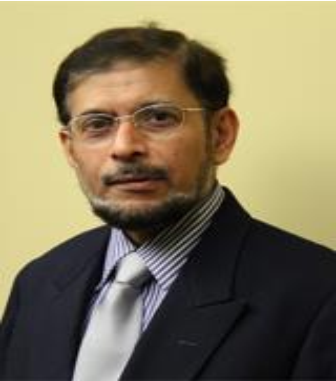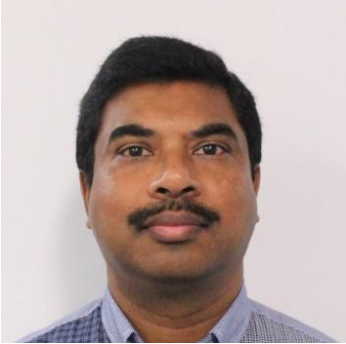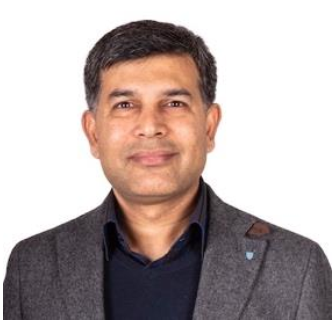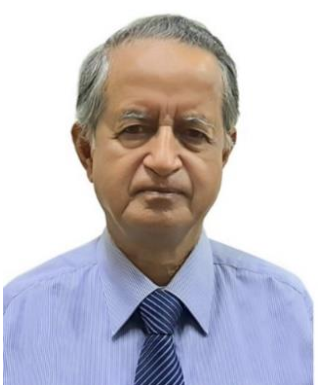Keynote Speakers
| Keynote Lecture 1: Title: Thermal Management in Buildings Using Phase Change Materials |
|
|---|---|
 |
Dr. Muhammad Mustafizur Rahman
Bloomfield Endowed Chair in Engineering and Professor of Mechanical Engineering Wichita State University Kansas, USA |
|
Keynote Abstract: Phase Change Materials (PCM) find wide applications for transient thermal control in several industry sectors, such as
reducing cost of energy to maintain thermal comfort in occupied space, transportation of blood, tissue, and organs, increasing
the reliability of electronic devices, power systems, and weapons used in warfare, and for renewable power generation. Use of
contained phase change materials (PCM) for this purpose is a simple, but quite effective and low-cost technical solution. PCM
changes from solid to liquid in an endothermic process by absorbing heat, and the liquid to solid phase change occurs when the
phase change material releases heat in an exothermic process. The presentation will discuss the state-of-the-art of phase change
materials for buildings applications and the limitations of incorporating phase change materials. The challenges include
supercooling, low thermal conductivity, phase segregation, fire safety, corrosion, and cost. This study explored how some of
these issues can be limited or eliminated. The energy consumption in residential buildings is mostly associated with the heating
and cooling load of the interior environment. The application of phase change materials has been demonstrated as a solution to
decrease the energy consumption of an apartment building for both heating and cooling. Keywords: Phase change material, Thermal management, Buildings applications, Energy consumption. Biography: Dr. Muhammad Mustafizur Rahman earned the Bachelor of Science in
Mechanical Engineering degree from Bangladesh University of Engineering and Technology in
Dhaka, Bangladesh in 1980; the Master of Science degree from University of Manitoba in
Winnipeg, Manitoba, Canada in 1983; and PhD from University of California, Berkeley in 1988.
He moved to Wichita State University (WSU) in August 2014 as the Bloomfield Endowed Chair
in Engineering and Professor of Mechanical Engineering after serving as a faculty member in the
Department of Mechanical Engineering at the University of South Florida (USF) for 21 years.
His research has been funded by NASA, US Department of Energy, US Department of Defense,
and industries in USA and Europe. Dr. Rahman served as the Chair of the Advanced Energy
Systems Division of American Society of Mechanical Engineers (ASME). He also served as an
Associate Technical Editor of the Journal of Solar Energy Engineering and the Journal of Energy
Resources Technology. He was a member of the Editorial Board in the International Journal of
Energy Research and currently a member of the Editorial Board in MIST International Journal of Science and Technology. Dr.
Rahman received the USF Outstanding Teaching Award, SAE (Society for Automotive Engineers) Teeter Educational Award,
ASME Florida West Coast Engineer of the Year Award, ASME Dedicated Service Award, and WSU Faculty/Staff Fundraising
Award. He is an ASME Fellow since 2007. He is a Mechanical Engineering program evaluator in the Engineering
Accreditation Commission of ABET (Accreditation Board for Engineering and Technology) and a Peer Corps Member in the
Higher Learning Commission for regional accreditation of educational institutions.
|
|
| Keynote Lecture 2: Title: Central-Southern Himalayan Region Hydropower Generation and Ecosystem |
|
 |
Firoz Alam
School of Engineering Cluster, Department of Aerospace, Mechanical and Manufacturing Engineering RMIT University, Melbourne AUSTRALIA |
|
Keynote Abstract: Exploiting hydro resources for power generation in Central Southern Himalayan region encompassing Nepal, Bhutan, India, and
China require constructing dams and storages in the Ganges and Brahmaputra River systems. Hydropower is not the main
portfolio of power in India and China, but Bhutan and Nepal are generating almost 100% of their electric power from hydro
resources. The generated hydropower not only meets the power needs of these two countries but also, they export the surplus
power to neighbouring country. Currently Bhutan generates 4 times more hydropower than its needs. A similar mega plan is
underway in Nepal. The Ganges and Brahmaputra River flow is the collection of pulses and not a uniform flow of water that
change during the day and year feeding continuously and sustainably millions of years developed upstream and downstream
ecosystem as well as human water consumption, food production and transport. To achieve a reliable electric power supply,
engineers smooth out the river pulses by constructing thousands of water storages and dams in Central Southern Himalayan region
to suit continuous power generation demand thereby making the Ganges and Brahmaputra River ecosystems as water pipes. These artificial changes and obstructions will have irreversible impact on these two important river ecosystems on which the livelihood
of over 600 million people depends. This paper highlights the needs for amalgamated approach involving expertise from
engineers, hydrologists, economists, environmentalists, ecologists, and most importantly the traditional beneficiaries from upper,
middle, and lower riparian nations for undertaking a comprehensive river ecosystem management plan, implementation,
monitoring, continuous assessment, and corrective measures collectively. Additionally, the paper discusses the need for utilization
of indigenous hydro resources for power generation that can be used beyond the national boundary in South Asia to enhance the
collective energy security for economic prosperity and social development. Keywords: Hydropower, Cross-border power trading, Ecology, Environment. Biography: Dr Firoz Alam is a Professor in the School of Engineering (Aerospace, Mechanical
and Manufacturing) at RMIT University in Melbourne, Australia. He completed his PhD in
vehicle aerodynamics from the same university in 2000. He received his Master’s degree
(combined with Bachelors) in Aeronautical Engineering with Honours (First Class First) from
Riga Civil Aviation Engineers Institute, former Soviet Republic of Latvia in 1991. Prof Alam’s
research interest includes thermal fluid mechanics, aerodynamics of aircraft, road vehicle, train,
building, sports, energy, engineering education curriculum design, quality assurance and
accreditation. He has over 300 publications (including scholarly books, book chapters, journal
articles and peer reviewed conference papers). He is currently serving as editor in chief and
editorial board member for over half a dozen international scientific journals. Prof Alam is a
Fellow of the Institution of Engineers Australia, Chartered Professional Engineer (CPEng), and
APEC Engineer. He is an active member of several other professional societies and associations including American Society of
Mechanical Engineers (ASME), American Institute of Aeronautics and Astronautics (AIAA), Society of Automotive Engineers
USA & Australia, and International Society of Bionic Engineering. Prof Alam received RMIT University’s best Teacher
Award in 2004.
|
|
| Keynote Lecture 3: Title: Nanofluids to Tackle Modern Thermal Management and Energy Challenges |
|
 |
S M Sohel Murshed
Professor, Department of Mechanical Engineering Instituto Superior Técnico, University of Lisbon, PORTUGAL |
|
Keynote Abstract: As the smaller and faster-based current trend of technological development leads to dramatic increase in the power densities
and heat flux in modern devices and systems, it’s more challenging to meet their thermal management demands than ever.
Smart and innovative thermal solutions and technologies are thus urgently needed to tackle such increasing challenges for the
thermal management of many important sectors such as electrical vehicles, microelectronics, power electronics equipment and
energy systems. Here comes the novel nanofluids, the suspension of nanoscale particles in heat transfer fluid, which show great
potential to meet such thermal management and energy performance demands. Having substantially increased thermophysical
properties and features, the impact of nanofluids technology is great considering that the thermal performance of heat
exchangers or other systems, processes is vital for numerous industries. For instance, the potential estimated world-wide
market for nanofluids only in heat transfer applications is a few billion dollars per year and it is expected to grow further and
rapidly over the next several years or decade.
Given the surge of research interests and activities as well as the enormous potential, this keynote first provides background of
nanofluids and a critical appraisal on their performance in thermal management for their advanced applications. Subsequently,
their roles and prospects in the energy sector particularly in solar energy utilization and conversion are discussed. Finally, this
speech answers the key question poised here- is this new class of fluids capable of meeting modern thermal management and
energy challenges. Biography: Dr. S M Sohel Murshed S M Sohel Murshed is currently a professor of
Thermofluids and Energy Conversion Technologies at the Department of Mechanical
Engineering of the Instituto Superior Técnico (IST), University of Lisbon, Portugal. Prof.
Murshed obtained his Ph.D. in Mechanical and Aerospace Engineering from Nanyang
Technological University (NTU) of Singapore in 2007. Previously he also worked at NTU,
Singapore and at UCF, Florida, USA. Prof. Murshed was visiting professor at several
universities and institutes such as Imperial College (UK), RIT (NY, USA), and IIT (India).Prof. Murshed has so far authored/coauthored 13 books, 35 book chapters, and more than 200 papers in leading international
journals and conferences. He has citations (Google Scholar) of 8800+ with h-index of 36. Many of his papers received
distinctions and have been classified as Highly Cited Papers (ranked in the top 1%) by the Web of Science. According to the
list of World's Top 2% Scientists published in October 2022, he is one of the leading (45th out of 763) scientists from Portugal.
For his exceptional scientific contributions and impact in the areas of Mechanical, Naval and Aerospace Engineering Prof.
Murshed received University of Lisbon’s Scientific Award 2022.
From 2016- 2020, Prof. Murshed served as a delegate (management committee) of Portugal to a European Cooperation in
Science and Technology (COST) Action, where he was also a group leader. He has regularly been acting as an expert panelist
and evaluator for the European Commission as well as funding agencies of many countries worldwide. He has been serving as
chief editor, associate editor and editorial member of a few international journals and holds membership of several
international societies and organizations
|
|
| Keynote Lecture 4: Title: Causes of Chatter Formation in Metal Cutting and Innovative Chatter Control Strategies |
|
 |
A.K. M. Nurul Amin
Department of Industrial and Production Engineering, MIST Dhaka, BANGLADESH |
|
Keynote Abstract: The paper will highlight the contribution of the manufacturing sector in the overall economy of major developed and some
developing countries. In the broader concept of manufacturing the position and role of metal cutting and machining will be
highlighted. The major challenge towards achieving high precision, good product quality and productivity will be addressed.
Chatter, a self-excited vibration in machining process, with its adverse effects will be introduced. The existing theories on
chatter problem will be summarized and the concept of Resonance theory of chatter will be introduced. The works of the
author on understanding the causes of chatter formation in turning and in end milling will be briefly discussed to explain the
justification for proposing the Chatter Resonance Theory of Chatter. Basic concepts of the Resonance theory will be presented.
Different Chatter control strategies developed by the author and his students with their effectiveness in controlling chatter will
be illustrated in brief. Finally, the contribution of the school of the author towards understanding the complex phenomenon of
chatter in machining through research and publication and innovation will be summarized. Keywords: Magnetic suspension, Magnetic Bearing, Mechatronics, Electromagnet, Permanent magnet. Biography: Dr. A. K. M. Nurul Amin is currently working as a Professor of Industrial and
Production Engineering Depart of MIST. He completed his Ph.D. in 1982 and Masters in MFG
in 1979 from the former USSR with CGPA of 5.00/5.00. He passed his SSC in 1969 and HSC in
1972 from FCC standing 14th and 2nd respectively in the combined merit lists of the Comillah
Board.
He joined IPE department of BUET as an Assistant Professor in 1983 after completion of his
Ph.D. and served BUET for 15 years in different academic and administrative position including
the Head of the IPE department.
He joined as Faculty Member of Manufacturing and Materials Engineering department of
International Islamic University Malaysia (IIUM) in 1997 taking sabbatical leave from BUET.
He left BUET in 2001 taking early pension to serve IIUM for a total of over 19 years in different
academic and administrative positions. He returned back to Bangladesh in 2016 and joined
AUST as a professor where he served for 2 years as Professor and Head of the MPE department. He left AUST in 2018 and
joined as a Professor of the IPE department of MIST in 2019 where he is currently posted.
He supervised 6 (six) PhD theses, 38 (Thirty Eight) Master’s theses and a large number of undergraduate theses.
He has published 274 (Two hundred and Seventy Four) referred journal and conference proceeding papers, 11 (Eleven) Books,
and 41 (Forty One) Book Chapters. He is the Chief Editor/Editor of 5 (Five) Books including the book entitled ‘Titanium
Alloys’ published by Intech Publisher. He has 3 (three) granted Malaysian patents and 2 (two) more pending decision.
He is currently the Executive Editor of MIST International Journal of Science and Technology (MIJST), which is a fully online
journal.
He completed 21 (twenty One) Funded National and Local Research Projects while at IIUM and currently conducting a funded
research project at MIST.
He is a Life Fellow of the Institution of Engineers, Bangladesh and Life Member, Bangladesh Association for Advancement of
Science, Bangladesh.
|
|
